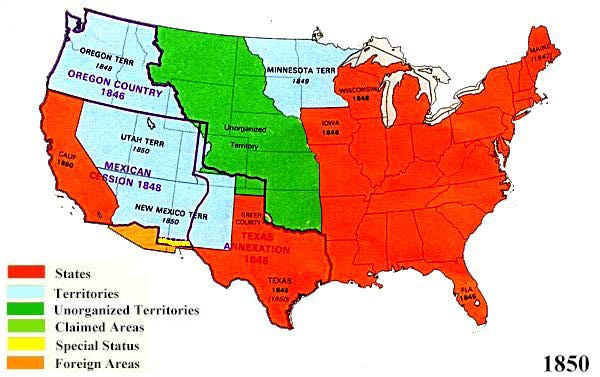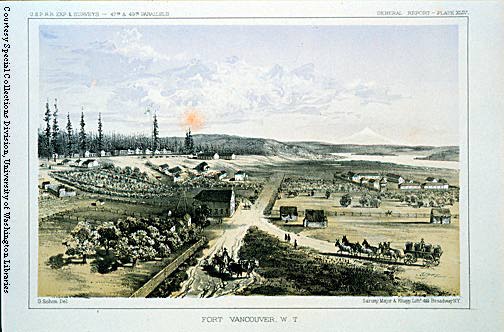Oregon and Washington
Fort Vancouver November 1850
From Reports of explorations and surveys to ascertain the most practicable and economical route for a railroad from the Mississippi River to the Pacific Ocean, 1860, v. 12, pt.1, pl.44 U.S Department of War University of Washington Collection
With the United States and its army arriving, the Oregon Territory would never be the same.
Oregon and Washington had several "Indian problems" that the army would be involved in during the 1850's, but generally the relations with the Native people of the area were good. The real trouble would not begin until American greed for land became earnest after the Civil War. The bigger problem for the Indians was caused by diseases that they had had no immunity to, such as measles and mumps. Disease caused a mortality rate of up to 90% for some of the western tribes.
In 1852 Ingalls friend and plebe year roommate at West Point, Sam Grant, was posted to Fort Vancouver. Ingalls and Grant spent their spare time riding their horses. They also planted 100 acres of potatoes that were flooded out by the Columbia River. Grant was unhappy with the separation from his beloved wife, Julia and even though he was with his friend, his time in Oregon and later in California were difficult for him. In 1854 Grant resigned from the army. His father plead with the Secretary of War, Jefferson Davis, not to accept his resignation. The resignation of Sherman was also pending at the same time.
Traveler Stephen Massett in his book Drifting About mentions what a fine reception Captain Ingalls and the others at Fort Vancouver give the visitors. He also writes "This is without doubt the finest location for a city or town, of any I have visited" and judging by the book he has visited many.
Rodney Gislan, an Army doctor, writes in his book Journal of Army Life about the parties given for the wedding of Lt. Willam Welcker to Katie Adair (the general's daughter) in August of 1857. There were three parties given, but "the most brilliant of all" was given by Captain Rufus Ingalls on the 30th.
Although better known later in life, Grant and Sherman were junior in rank to Ingalls during this time.
In early 1854 Rufus was in Washington, DC where he was ordered to accompany the Steptoe Expedition from Fort Leavenworth (Kansas) across the continent to the Pacific coast.
The US appointed Isaac I. Stevens to be governor of the newly created Washington Territory in 1854. Stevens had been a Topographer with the coastal survey (the predecessor of NOAA). He was known for his harsh treatment of the Native American tribes during his term as governor. The Washington Territory consisted of the states of Washington and Idaho with a portion Montana.

